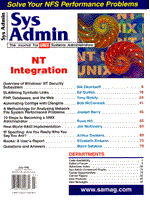
Sidebar : Raid OverviewThere are many different levels of RAID. I will briefly discuss a few of them. See the article by Gilbert Held in the February 1998 issue of Sys Admin for a more complete discussion. RAID Level 0 RAID level 0 is known as striping. This is where data (raw or file system) is spread across multiple drives. Pros: Fast (data striping allows for I/O load balancing across the drives in a volume) and cheap (if you need 10 GB of storage, you buy 10 GB of storage). Cons: No fault tolerance. If you have 20 GB spread across 5 drives and you lose 1 drive, then you lose all of your data. RAID Level 1 RAID level 1 is data mirroring. Each disk has an exact duplicate. Pros: Benefits of full data redundancy without the overhead of parity. Increased throughput on reads due to load balancing across mirrored drives. Cons: Decreased throughput on writes, since the mirror write must be completed before the write is considered complete (maskable with the proper amount and type of cache). 50% loss of actual drive capacity due to mirroring. RAID Level 5 RAID level 5 is striped, interleaved parity (parity is spread across all of the drives in the volume). Pros: Fault tolerance (if one drive dies, then the data can be accessed from the parity on the remaining drives) and increase throughput due to striping. Only using N+1 drives to achieve effective capacity of N drives. Good balance of fault tolerance and speed for OLTP database applications. Parity is also striped across the drives in the volume to avoid the bottleneck of a dedicated parity drive as used in RAID level 3. Cons: Write penalty on throughput due to parity processing (maskable with the proper amount and type of cache). Fault tolerance is limited to the loss of one drive. RAID Level 10 RAID level 10 (also known as RAID level 0+1 or RAID level 1+0) is striped mirrors. This provides the most fault tolerant solution and is usually faster than other RAID levels. Pros: Benefits of full data redundancy without overhead of parity and increased throughput optimization due to striping. Loss of up to 50% of the drives is acceptable.
Cons: 50% loss of actual drive capacity due to mirroring.
|